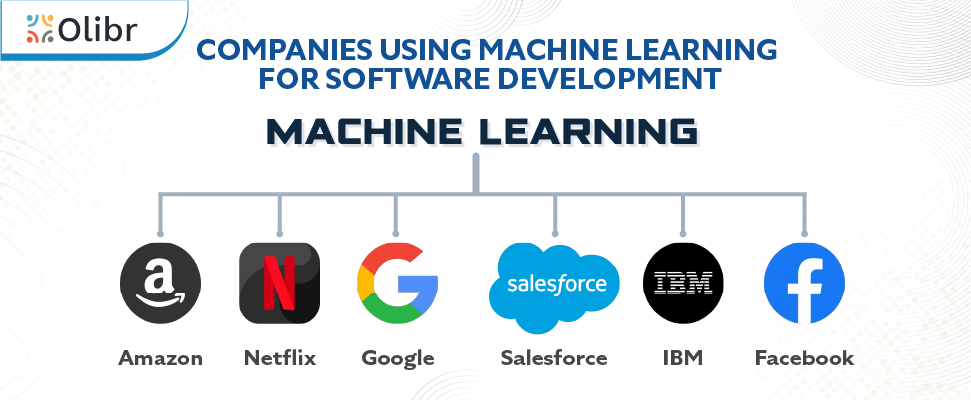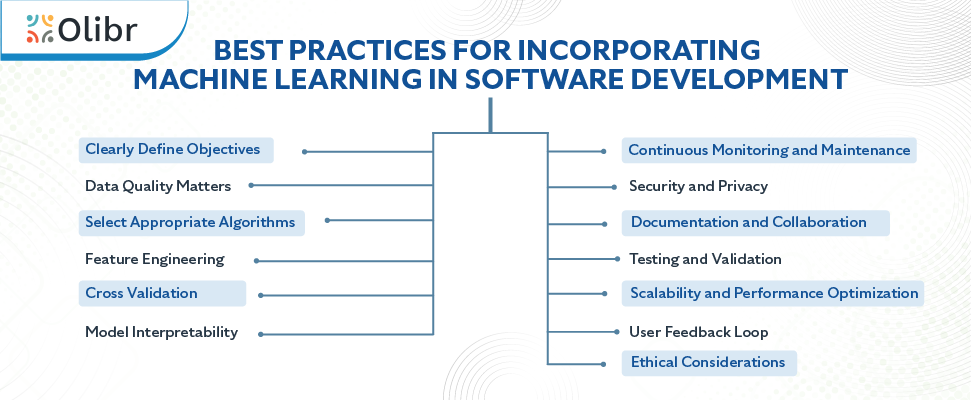Table of Contents
ToggleIntroduction
The recent surge in the AI market has led to many companies experimenting with new technologies, including machine learning and deep learning models. The number of companies harnessing the power of machine learning and AI for their businesses has been growing and a healthy rate. McKinsey Global Survey on AI 2022 revealed that compared to 2017, AI adoption increased more than double in number in 2022. This only makes it imperative that machine learning engineers and businesses understand how to harness machine learning in software development. Let’s read more to understand this.
What is Machine Learning?
IBM defines machine learning as “a branch of artificial intelligence (AI) computer science that focuses on the using data and algorithms to enable AI to imitate the way that humans learn, gradually improving its accuracy.” The learning system of an ML algorithm can be divided into three parts. First, there is a decision process where machine learning algorithms classify something or make predictions based on some input data. This is followed by an error function where the prediction of the machine learning model is compared to known examples for accuracy. Finally, comes the model optimization process where the model is adjusted for maximum accuracy based on the data points in the training set.
Based on the way of learning and the methods, there are four types of machine learning:
- Supervised Machine Learning: The machines are trained using a labeled dataset and the ML model predicts the output based on the training.
- Unsupervised Machine Learning: The machines are trained against datasets that are unclassified and not labeled.
- Semi-Supervised Machine Learning: It uses the combination of labeled and unlabeled datasets during the training period.
- Reinforcement Learning: It is a type of ML where the agent is rewarded for each good outcome and penalized for a bad outcome.
Practical Applications of Machine Learning in Software Development
From home assistants to sleep trackers, machine learning is everywhere. Let’s look at a few applications of machine learning.
Face, Speech, and image recognition
A machine learning model’s capability to identify people, places, digital images, and voices helps apps like Facebook, Instagram, Shazam, and Pinterest offer great user experience. For instance, the face detection feature helps you tag friends on social media apps.
Product recommendations
Many eCommerce companies and OTT platforms use machine learning software to offer product recommendations to users based on their online behavior. For example, when we search for a product on Amazon, we might see ads related to similar products on the other pages we browse.
Self-driving cars
Tesla is known for its self-driving cars. This is perhaps the most interesting application of unsupervised machine learning methods to train the car to detect people and objects while driving.
Virtual personal assistants
Siri, Bixby, Alexa, and Google Assistant are examples of virtual assistants using machine learning algorithms to help us in various ways.
Online fraud recognition
Machine learning models can be trained to detect suspicious online transaction patterns. This allows banks and other financial institutions to detect financial fraud by comparing genuine and fraudulent behavior.
Email automation
Machine learning models help in filtering out spam emails from our inboxes. It studies email-sending behavior and detects user patterns that tell the ML model that some emails are undesirable.
Companies Using Machine Learning for Software Development

Amazon: Online shopping websites like Amazon use machine learning algorithms to make product recommendations and detect fraud. ML also helps these eCommerce businesses manage their inventory, automate customer service tasks, and support minimum use of boxes wherever possible.
Netflix: Many OTT platforms like Netflix use machine learning algorithms to study user behavior. This helps Netflix to personalize recommendations for subscribers based on their viewing history.
Google: A lot of tasks that Google does, from helping us with image recognition, email spam filtering, and targeted ads are taken care of by machine learning. Google also uses machine learning to improve search engine performance and develop new products and features.
Salesforce: The CRM of companies like Salesforce uses machine learning. ML also helps Salesforce with ML-driven chatbots automation and personalized marketing campaigns.
IBM: Apart from deploying and integrating ML models into applications through its cloud service, IBM also offers tutorials on machine learning to help users understand practical ML applications.
Facebook: The popular social networking platform uses machine learning for personalizing the ads that you see on your feed. Facebook also used ML algorithms to identify objects, people, and even emotions in images and videos. Machine learning also helps Facebook with language translation, spam filtering, and predictive analysis.

Don't miss out on your chance to work with the best!
Apply for top job opportunities today!
Challenges in Harnessing Machine Learning
Problems with Data
The most crucial component in machine learning is datasets. Poor quality data, biased data, insufficient data, and imbalanced data lead to many problems. Faulty data can cause inaccurate or faulty predictions from an algorithm. Hence, one needs to ensure that the machine learning model gets datasets that are filtered with precision.
Navigating Regulatory Compliance
In the machine learning landscape, dealing with regulatory compliance is a huge challenge. There are many conflicts in sensitive areas such as medical diagnosis or video surveillance, as it can be difficult to balance the legal aspect and collect quality data. Data Science experts should be well-versed in regulatory compliance so that robust machine learning frameworks can be created without any conflict.
Complexity of Machine Learning
Machine learning technology itself is still new and complex and this makes it difficult to find answers to every issue related to it. Therefore, managing an AI/ML project is a high risk, but a high reward domain. Eventually, with the advancements in the field, there will be more people who understand the machine learning landscape.
Overfitting and Underfitting
Noise and inaccuracies from a large dataset (overfitting) or a model too simple for a given dataset (underfitting) can affect the performance of machine learning models to a great extent. Adjusting constraints, increasing the complexity of the ML model, and using better features can help avoid the problem of incomplete and inaccurate predictions.
Lack of Skilled ML experts
As mentioned earlier, machine learning is still new and there aren’t many skilled professionals in the field. Interestingly, there is a growing demand for qualified professionals who can use ML technologies to the extent that the supply of professional ML experts is unable to match the demand from businesses. However, in the future, the domain is expected to have more skilled data scientists and machine learning engineers.
Best Practices for Incorporating Machine Learning in Software Development
- Define Objectives Clearly: It is a bad idea to start an ML model without understanding what the business objective is. Machine learning models set up without considering the business goal are set for failure. Therefore, it is crucial that you have a clear understanding of the problem and how you will find the solution.
- Data Quality Matters: Machine learning engineers can start with a less complicated model that can work with simple data, and gradually increase the complexity. This helps you invest time in collecting good data, cleaning the datasets as required, and pre-processing the data to avoid failures and inaccuracies.
- Select Appropriate Algorithms: It is important to invest time in choosing machine learning algorithms that are well-suited to the problem. For instance, decision trees work best for classification projects. It is good practice to experiment with different algorithms to find the best fit.
- Feature Engineering: The machine learning model should have the right features input into it so that it can offer optimal performance. Feature engineering refers to using the right variables so that the model offers accuracy.
- Monetization: Developers can create and sell machine learning software and hardware components. They could also offer subscription-based services, which can lead to potential revenue streams.
- Cross-Validation: Using cross-validation techniques helps you assess how accurately the machine learning model will generalize to new, unseen data. This helps prevent overfitting and provides a more accurate estimation of model performance.
- Model Interpretability: It is a good practice to use techniques that help you prioritize model interpretability. This is especially useful in applications where transparency is crucial. Features such as importance analysis, model visualization, and LIME (Local Interpretable Model-agnostic Explanations) can be used to understand how the ML model makes decisions.
- Continuous Monitoring and Maintenance: Automated pipelines should be set up so that the ML models receive regular updates. It is important to continuously monitor and retrain the machine learning models based on the new datasets and the regular changes in the field.
- Security and Privacy: Sensitive data must be protected through robust security measures. Additionally, it is also important to take care of compliance with data privacy regulations. ML experts can consider techniques like federated learning to preserve user privacy.
- Documentation and Collaboration: One of the easiest ways to improve how machine learning models work is to maintain comprehensive documentation for the projects. This also helps future machine learning professionals have ready data sources, preprocessing steps, and model details. Additionally, collaboration between data scientists, developers, and domain experts can help foster a holistic understanding of the project.
- Testing and Validation: All software models, including machine learning models, should go through rigorous tests so that they are validated before deployment. You can implement unit tests, integration tests, and validation tests to catch issues early.
- Scalability and Performance Optimization: Always remember that the size of the project is expected to increase in the long term. Hence, it makes sense to plan for scalability from the beginning. Distributed computing and cloud resources can be used to handle large datasets and high user loads. You can also optimize algorithms and data pipelines for performance and efficiency.
- User Feedback Loop: Establishing a feedback loop with end-users helps continuously improve the machine learning application. User feedback can provide valuable insights for model refinement.
- Ethical Considerations: Machine learning engineers should be cautious of the elements that could lead to ethical conflicts. It is important to be aware of bias in data and model outputs. You can promote fairness-aware machine learning to tackle bias.
Conclusion
Machine learning analytics can be used to uncover new areas and improve how businesses operate. While it is true that machine learning is a new field, the opportunities to study machine learning models and improve them for businesses are plentiful. Incorporating machine learning in software development involves carefully studying the challenges and looking for innovative solutions while keeping in mind ethical concerns and best practices. If you are a developer with experience in handling machine learning projects, sign up with Olibr now for exciting job opportunities and more!
Take control of your career and land your dream job!
Sign up and start applying to the best opportunities!

FAQs
A Machine Learning Engineer is a professional who specializes in designing and developing machine learning systems. You should have strong programming skills, data science knowledge, a good understanding of machine learning algorithms, and experience working with programming languages, frameworks, and libraries to become a Machine Learning Engineer.
Platforms such as Coursera, edX, Udemy, DataCamp, Udacity, and Kaggle, are platforms that have data science and machine learning courses to suit a variety of learning requirements.
Software development is the process used to create software. It includes a series of activities related to designing, creating, testing, and maintaining computer programs and applications.
Tata Consultancy Services (TCS) is the largest software development company in India. It employs more than 500,000 people and operates across 46 countries.
Classification in machine learning is to categorize the input data into predefined classes or categories based on their features. It is of two types: binary classification and multi-classification.
Some of the beginner-friendly machine learning projects are Stock Price Predictors using TimeSeries, Credit Card Fraud Detection, Music Recommendation System, Movie Recommendation System, and Spam Detection using Count Vectorizer.
Software developer skills that you must have are good programming skills in Python or R, algorithms, and frameworks. You must have hands-on experience using visualization tools. Lastly, she is well-versed in mathematics and statistics.
The different types of software development models are the waterfall model, agile methodology, scrum, spiral model, and lean development.



